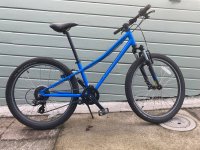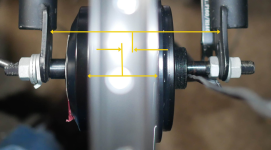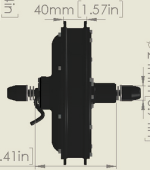Some early data from a Leaf "1500W" ordered in early April, 2024:
Config: 35H, "
4T," prelaced into an 80mm 406 rim, 170mm dropout fitment, cassette option
Mass:
10.74kg (with spokes, rim, 60cm motor cable, preterminated with ring lugs and a rectangular Hall connector)
Axle:
225mm length, 85mm CL-to-shoulder on both sides, M14-2.0 threads on cassette side, M16-2.0 threads on the brake disc/cable side
Phase wiring: consistent with
4mm² cross sectional area
Ls, LCR bridge @10kHz, 1Vrms:
81µH (with ~60cm phase wiring)
Ls, Baserunner, 50.0V bench supply:
83µH (with ~60cm phase wiring)
Rs, 10Adc @ 23°C:
43.5mΩ (with ~60cm phase wiring)
Rs, Baserunner, 50.0V bench supply :
47mΩ (with ~60cm phase wiring)
KV, 50.0V supply on homebuilt trap controller:
12.5rpm/V
KV, Baserunner, 50.0V bench supply:
12.27rpm/V
There was a white wire in the wiring harness, but I haven't cracked open the motor yet to mod it; not connected to anything on the controller side.
I put a 100-406 tire on it, measured diameter 564mm (~22.2") after calibrating against GPS speed.
I cut off the stock connectors, and reterminated it to a Cusmade L1019 connector to Grin pinout. With a Grin Baserunner L10 at 30A batt/1500W batt/60A phase powering it, I threw it in a Juiced Hyperscorpion chassis, and took it out on a ~110mile ride to Redwood Regional near Oakland for a gathering:
View attachment 353140
Battery pack was a 14s25p Samsung 35E(1) pack, about 4 years of calendar age. Drew 3577Wh total, with a finishing OCV of 47.8V. Speed was a mix, but mostly at a ~40kph/25mph limit.
Overall: What a beast of a motor! Since I hadn't had time to Statorade it and mount a VESC variant to it, just threw the Baserunner on as a known-good solution. I was wishing for more torque off the line on some of the hills >8%, where I had to really stomp on the pedals to get the bike going, but once in motion, the motor performed pretty nicely for my taste. Definitely interested in seeing what it's capable of in this chassis with a thermistor and something like ~100A of peak phase current.













